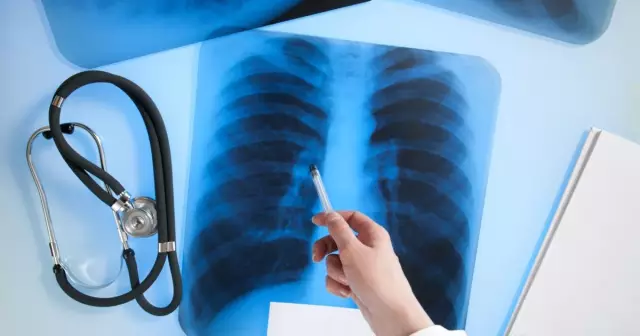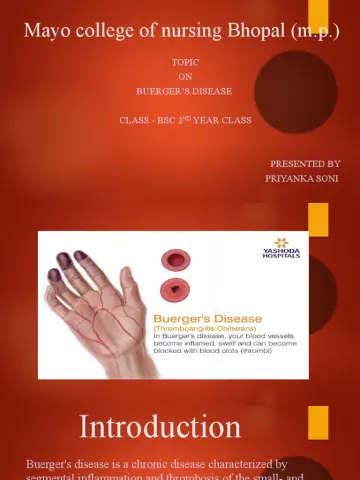- Author Rachel Wainwright [email protected].
- Public 2023-12-15 07:39.
- Last modified 2025-11-02 20:14.
Cuckoo with sinusitis: what is it, a description of the procedure
The content of the article:
- Preparation and procedure
- Cuckoo at home
- Video
Sinusitis is an inflammatory disease of the maxillary sinuses. It is characterized by the accumulation of pus in the maxillary sinuses. The most common cause of inflammation is infection in the upper respiratory tract.

Cuckoo - a method of flushing the sinuses with sinusitis
The development of the disease can be facilitated by:
- curvature of the nasal septum;
- polyps of the nose;
- chronic diseases such as chronic adenoiditis, chronic hyperplastic rhinitis;
- allergic rhinitis;
- spread of inflammation from other infectious foci, for example, with osteomyelitis;
- violation of the integrity of the sinus wall during dental manipulations on the upper jaw.
Symptoms of sinusitis are headache or pain in the bridge of the nose, aggravated by pressure, laughing, coughing, sneezing, tilting the head. There are also complaints of nasal congestion and a change in the timbre of the voice, the appearance of copious, viscous, greenish discharge from the nose, fever and general weakness. In a chronic process, a loss of smell and a decrease in taste recognition, rapid fatigue, frequent headaches, dryness of the nasal mucous membranes, decreased immunity, and concomitant diseases such as tonsillitis, pharyngitis, bronchitis are possible.
To confirm the diagnosis, an x-ray of the sinuses, a bacteriological culture of the discharge are prescribed. If necessary, computed tomography of the paranasal sinuses is done.

The cuckoo procedure is prescribed by an otolaryngologist
Treatment is prescribed by ENT. It consists in the selection of drug therapy, including broad-spectrum antibiotics, vasoconstrictors, antihistamines, nasal lavage according to Proetz.
The cuckoo procedure for sinusitis is a method of rinsing the nose (nasal lavage, nasal irrigation) to cleanse the maxillary sinuses and nasal passages of mucus and pus. It was developed by the American otolaryngologist A. Proetz at the beginning of the twentieth century and is often used for many inflammatory diseases of the upper respiratory tract: sinusitis, rhinitis, tonsillitis, adenoiditis. The name "the method of moving liquid according to Proetz" is not as well known as "cuckoo". This is due to the fact that during this procedure, at a certain stage, the patient is advised to repeat the “peek-a-boo” to avoid liquid entering the respiratory tract through the nasopharynx.
Contraindications for holding a cuckoo are:
- epilepsy;
- nosebleeds;
- mental disorders;
- allergy to the drugs used.
Treatment of sinusitis with a cuckoo is contraindicated in children under five years old, which is associated with age-related features of the structure of the nasal passages.
Preparation and procedure
Before the start of lavage, local anesthesia of the nasal mucosa is performed. With severe edema, vasoconstrictor drugs are used, for example, drops of Xylometazoline, Oxymetazoline.

The method of moving fluid according to Proetz is aimed at cleansing the paranasal sinuses from stagnant pus and mucus
For the procedure, the following solutions are used: Chlorhexidine, Miramistin, Octenisept, Dekasan, Dioxidin, Furacilin, Physiological solution (0.9% NaCl).
The main properties of the solutions used:
- Chlorhexidine, Miramistin, Octenisept and Furacilin: antiseptic solutions. They are effective in the presence of gram-positive and gram-negative bacteria.
- Dekasan: has antiviral, antibacterial and antifungal effects. A 0.02% solution is used to irrigate the sinuses.
- Dioxidine: antibacterial.
- Saline solution: helps to moisturize and regenerate the nasal mucosa.
The solutions used for rinsing should be warm (room temperature or body temperature) for a more comfortable feeling during the session.
Usually, the procedure requires from 100 to 200 ml of liquid, but if the inflammatory process is running, a larger amount of solution may be needed.
The duration of the session on average takes from 10 to 15 minutes.
The manipulation is carried out in the supine position with the head thrown back 45 degrees. The procedure is as follows: a medicinal solution is poured into one nasal passage using a syringe with a thin catheter, which is simultaneously sucked out through the other nostril with a special tube connected to the suction. The essence of the method is to create negative pressure, which facilitates the outflow of the contents of the maxillary sinus. The medicine, circulating from one half of the nose to the other, helps to flush stagnant pus and mucus from the paranasal sinuses.
Thus, thanks to this manipulation, the contents of the sinuses are evacuated and the mucous membranes are simultaneously disinfected. After the end of the nasal lavage, it is recommended to lie down with your head down for 30 minutes. In the cold season, you should not rush to go outside, as the presence of a small amount of solution remaining in the sinuses can lead to hypothermia. Better to wait 60-90 minutes.
As a result of rinsing the nose, thick mucus and pus in the maxillary sinuses are liquefied and well excreted, the cavity and sinuses are disinfected, and the swelling of the nasal mucosa is removed. After the first session, all this leads to a subsiding of the inflammatory process and relief of breathing. General well-being also improves, the temperature decreases.
Usually, 5 to 10 sessions are prescribed. The exact number of procedures is determined by the doctor individually.
After washing, the patient may experience discomfort and burning in the nose, pain and heaviness in the head, nausea and vomiting, sneezing, redness of the eyes, congestion of the ears, damage to the mucous membrane of the nasal passages, slight nosebleeds.
Cuckoo at home
Carrying out a cuckoo with sinusitis is possible not only in a hospital, but also at home. You can ask the doctor to explain and show in detail how to do the flushing, and carry it out in the future independently, using a syringe with a soft catheter or other device for administering a medicinal solution and a rubber bulb for suction. This is especially true for people with chronic sinusitis, who periodically experience exacerbations. This will prevent the deterioration of the condition and the development of complications.

If necessary, the procedure can be carried out independently at home
Numerous positive reviews about the cuckoo procedure prove its effectiveness in the treatment of sinusitis and other inflammatory diseases of the upper respiratory tract. As a rule, in addition to prescribing medicines and cuckoo sessions, doctors recommend breathing exercises, which include special exercises that can reduce swelling and nasal congestion.
Video
We offer you to watch a video about the cuckoo procedure for sinusitis.

Alina Ervasova Obstetrician-gynecologist, consultant About the author
Education: First Moscow State Medical University. THEM. Sechenov.
Work experience: 4 years of work in private practice.
Found a mistake in the text? Select it and press Ctrl + Enter.






